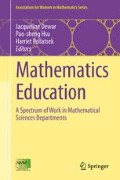Abstract
Roosevelt University is a private, comprehensive master’s institution with a social justice mission. Faculty are expected to cultivate excellent teaching, create significant amounts of research, and perform much service work. It is challenging to find time for all three when they are approached as distinct tasks. The mathematics department has developed creative activities that integrate all of these professional responsibilities resulting in a significant change in departmental culture. Faculty have added large- and small-scale projects to courses. They are now working with more students on undergraduate research and have created a venue, the Math x-Position, to showcase student work. This was all accomplished by ongoing faculty mentoring, combining teaching and research, and by fostering a safe environment for innovation.
MSC Codes
97A99
97B99
Access this chapter
Tax calculation will be finalised at checkout
Purchases are for personal use only
Notes
- 1.
PIC Math is “a Mathematical Association of America and Society for Industrial and Applied Mathematics program with support provided by the National Science Foundation (DMS-1345499). It aims to prepare mathematical sciences students for industrial careers by engaging them in research problems that come directly from industry. A strong component of PIC Math involves students working as a group on a semester-long undergraduate research problem from business, industry, or government” (PIC Math n.d.).
- 2.
SENCER is the signature program of the National Center for Science and Civic Engagement (NCSCE). “SENCER applies the science of learning to the learning of science, all to expand civic capacity. SENCER courses and programs connect science, technology, engineering, and mathematics content to critical local, national, and global challenges” (SENCER n.d.). NCSCE is a “national organization that supports a community of teachers and learners. Through grant funding, we help educators in and outside the classroom make connections between the content they teach and real world issues of civic importance” (NCSCE n.d.).
- 3.
“Funded through the National Science Foundation’s TUES-II program (DUE-1322883), the Engaging Mathematics 3-year initiative aims to significantly increase the use of the SENCER model, and other reformative pedagogies, by a national community of mathematics scholars capable of creating, implementing, and sustaining reforms in mathematics education. Engaging Mathematics is an initiative of the NCSCE” (Engaging Mathematics n.d.).
- 4.
“Flipping the classroom is a pedagogical strategy that replaces the standard lecture-in-class format with opportunities for students to review, discuss, and investigate course content with the instructor in class. There are many ways in which a classroom can be flipped, but the underlying premise is that students review lecture materials outside of class and then come to class prepared to participate in instructor-guided learning activities” (Hughes 2014, p. 137).
- 5.
SoTL is the intellectual work that faculty members do when they use their disciplinary knowledge (in our case, mathematics) to investigate a question about their students’ learning (and their teaching), submit their findings to peer review , and make them public for others to build upon (Dewar and Bennett 2015).
References
Boring, A., Ottoboni, K., & Stark, P. B. (2016). Teaching evaluations (mostly) do not measure teaching effectiveness. Science Open. doi: 10.14293/S2199-1006.1.SOR-EDU.AETBZC.v1.
Chicago Symposium Series: Excellence in Teaching Mathematics and Science. Research and Practice. (2016). Retrieved March 8, 2016 from https://www.math.uic.edu/chicagosymposium.
Cohen, S., González-Arévalo, B. & Pivarski, M. (2016) Students as partners in curricular design: Creation of student-generated calculus projects. arXiv:1605.06333.
Dewar, J., & Bennett, C. (Eds.). (2015). Doing the scholarship of teaching and learning in mathematics. Washington, DC: Mathematical Association of America.
Engaging Mathematics. (n.d.). Retrieved May 3, 2016 from http://engagingmathematics.ipower.com/.
González-Arévalo, B. & Pivarski, M. (Winter 2013) The real-world connection: Incorporating semester-long projects into integral calculus. Science Education and Civic Engagement: An International Journal. http://seceij.net/seceij/winter13/real_world_conn.html.
Hughes, H. (2014). Flipping the college classroom: Participatory learning, technology, and design. In L. Kyei-Blankson & E. Ntuli (Eds.), Practical applications and experiences in K-20 blended learning environments (pp. 137–152). Pennsylvania: Information Science Reference (IGI Global).
Janke, S. (1993). Modeling the AIDS epidemic. In P. Straffin (Ed.), Applications of calculus. MAA Notes No. 29 (pp. 210–221). Washington, DC: Mathematical Association of America.
Kim, B., & Szpunar, D. (2010). Integrating teaching experience into an introductory chemistry course: The chemistry of global warming. Science Education & Civic Engagement: An International Journal. Retrieved June 19, 2016 from http://seceij.net/seceij/summer10/integrating_tea.html/.
Kooken, J., Welsh, M., McCoach, D., Johnston-Wilder, S., & Lee C. (2015). Development and Validation of the mathematical resilience scale. Measurement and Evaluation in Counseling and Development. doi: 10.1177/0748175615596782.
MicroPlants, A Zooniverse Project. (2016). Retrieved March 8, 2016 from http://microplants.fieldmuseum.org/.
NCSCE. (n.d.). National Center for Science and Civic Engagement. Retrieved May 3, 2016 from http://ncsce.net/about/.
PIC Math. (n.d.). Preparation for industrial careers in mathematical sciences. Retrieved May 3, 2016 from http://www.maa.org/pic-math.
SALG. (n.d.) Student assessment of learning gains. Retrieved March 7, 2016 from http://www.salgsite.org.
SENCER. (n.d.). Science education for new civic engagements and responsibilities. Retrieved May 3, 2016 from http://www.sencer.net/.
Stark, P. B., & Freishtat, R. (2014). An evaluation of course evaluations. Science Open. doi:10.14293/S2199-1006.1.-.AOFRQA.v1.
Wentz-Hunter, K. (2009). Cellular and molecular biology: Cancer. SENCER. Retrieved March 8, 2016 from http://serc.carleton.edu/sencer/cellularbiology_cancer/index.html.
Weiner, L. (2005). Roosevelt University. The Electronic Encyclopedia of Chicago. Chicago Historical Society. Retrieved March 9, 2016 from http://www.encyclopedia.chicagohistory.org/pages/1093.html.
Author information
Authors and Affiliations
Corresponding author
Editor information
Editors and Affiliations
Rights and permissions
Copyright information
© 2016 Springer International Publishing Switzerland
About this chapter
Cite this chapter
Cohen, S., González-Arévalo, B., Pivarski, M. (2016). A Departmental Change: Professional Development Through Curricular Innovation. In: Dewar, J., Hsu, Ps., Pollatsek, H. (eds) Mathematics Education. Association for Women in Mathematics Series, vol 7. Springer, Cham. https://doi.org/10.1007/978-3-319-44950-0_15
Download citation
DOI: https://doi.org/10.1007/978-3-319-44950-0_15
Published:
Publisher Name: Springer, Cham
Print ISBN: 978-3-319-44949-4
Online ISBN: 978-3-319-44950-0
eBook Packages: Mathematics and StatisticsMathematics and Statistics (R0)

